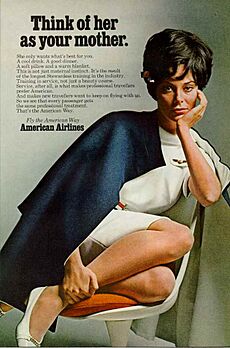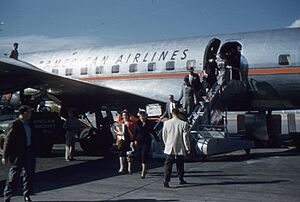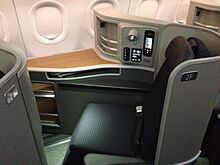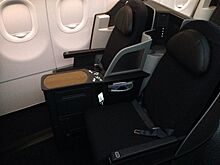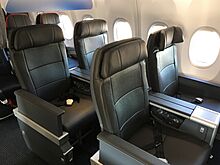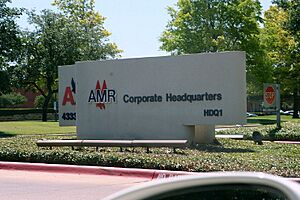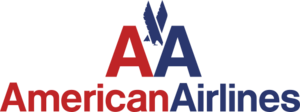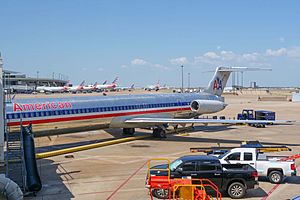American Airlines facts for kids
| Founded | April 15, 1926 (as American Airways, Inc.) |
|---|---|
| Commenced operations | June 25, 1936 |
| AOC # | AALA025A |
| Hubs |
|
| Frequent-flyer program | AAdvantage |
| Alliance | Oneworld |
| Fleet size | 961 |
| Destinations | 353 |
| Parent company | American Airlines Group |
| Headquarters | Fort Worth, Texas, United States |
| Key people |
|
| Employees | 103,200 (2023) |
American Airlines is a major airline in the United States headquartered in Fort Worth, Texas, within the Dallas–Fort Worth metroplex. It is the largest airline in the world when measured by scheduled passengers carried, revenue passenger mile. American, together with its regional partners and affiliates, operates an extensive international and domestic network with almost 6,800 flights per day to nearly 350 destinations in 48 countries. American Airlines is a founding member of the Oneworld alliance. Regional service is operated by independent and subsidiary carriers under the brand name American Eagle.
American Airlines and American Eagle operate out of 10 hubs, with Dallas/Fort Worth International Airport (DFW) being its largest. The airline handles more than 200 million passengers annually with an average of more than 500,000 passengers daily. As of 2023[update], the company employs 103,200 staff members.
Contents
History
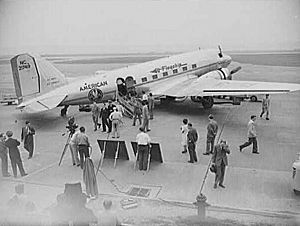
American Airlines was started in 1930 as a union of more than eighty small airlines. The two organizations from which American Airlines originated were Robertson Aircraft Corporation and Colonial Air Transport. The former was first created in Missouri in 1921, with both being merged in 1929 into holding company The Aviation Corporation. This, in turn, was made in 1930 into an operating company and rebranded as American Airways. In 1934, when new laws and attrition of mail contracts forced many airlines to reorganize, the corporation redid its routes into a connected system and was renamed American Airlines. The airline fully developed its international business between 1970 and 2000. It purchased Trans World Airlines in 2001.
American had a direct role in the development of the Douglas DC-3, which resulted from a marathon telephone call from American Airlines CEO C. R. Smith to Douglas Aircraft Company founder Donald Wills Douglas Sr., when Smith persuaded a reluctant Douglas to design a sleeper aircraft based on the DC-2 to replace American's Curtiss Condor II biplanes. (The existing DC-2's cabin was 66 inches (1.7 m) wide, too narrow for side-by-side berths.) Douglas agreed to go ahead with development only after Smith informed him of American's intention to purchase 20 aircraft. The prototype DST (Douglas Sleeper Transport) first flew on December 17, 1935, the 32nd anniversary of the Wright Brothers' flight at Kitty Hawk, North Carolina. Its cabin was 92 in (2.3 m) wide, and a version with 21 seats instead of the 14–16 sleeping berths of the DST was given the designation DC-3. There was no prototype DC-3; the first DC-3 built followed seven DSTs off the production line and was delivered to American Airlines. American Airlines inaugurated passenger service on June 26, 1936, with simultaneous flights from Newark, New Jersey, and Chicago, Illinois.
American also had a direct role in the development of the DC-10, which resulted from a specification from American Airlines to manufacturers in 1966 to offer a widebody aircraft that was smaller than the Boeing 747, but capable of flying similar long-range routes from airports with shorter runways. McDonnell Douglas responded with the DC-10 trijet shortly after the two companies' merger. On February 19, 1968, the president of American Airlines, George A. Spater, and James S. McDonnell of McDonnell Douglas announced American's intention to acquire the DC-10. American Airlines ordered 25 DC-10s in its first order. The DC-10 made its first flight on August 29, 1970, and received its type certificate from the FAA on July 29, 1971. On August 5, 1971, the DC-10 entered commercial service with American Airlines on a round trip flight between Los Angeles and Chicago.
In 2011, due to a downturn in the airline industry, American Airlines' parent company, the AMR Corporation, filed for bankruptcy protection. In 2013, American Airlines merged with US Airways but kept the American Airlines name, as it was the better-recognized brand internationally; the combination of the two airlines resulted in the creation of the largest airline in the United States, and ultimately the world.
Destinations and hubs
Destinations
As of July 2022, American Airlines flies to 269 domestic destinations and 81 international destinations in 58 countries (as of August 2022) in five continents.
Hubs

American currently operates ten hubs.
- Charlotte – American's hub for the southeastern United States and secondary Caribbean gateway. Its operations in Concourse E are the largest regional flight operation in the world. American has about 91% of the market share at CLT, making it the largest carrier at the airport. It is a former US Airways hub.
- Chicago–O'Hare – American's hub for the Midwest. American has about 35% of the market share at O'Hare, making it the airport's second largest airline after United.
- Dallas/Fort Worth – American's hub for the southern United States and largest hub overall. American currently has about 87% of the market share at DFW, making it the largest carrier at the airport. American's corporate headquarters are also in Fort Worth near the airport. DFW serves as American's primary Transpacific hub, primary gateway to Mexico and its secondary gateway to Latin America.
- Los Angeles – American's hub for the West Coast and secondary transpacific gateway. Though American has increasingly reduced its network out of Los Angeles, citing many long-haul international routes as unprofitable, it still maintains a limited amount of transatlantic and transpacific flights.
- Miami – American's primary Latin American and Caribbean hub. American has about 68% of the market share in Miami, making it the largest airline at the airport.
- New York–JFK – American's primary transatlantic hub mostly serving destinations that see high demand from local New York traffic. American has about 13% of the market share at JFK, making it the third largest carrier at the airport behind Delta and JetBlue.
- New York–LaGuardia – American's New York hub for domestic flights with a few exceptions. Most flights are operated by American Eagle.
- Philadelphia – American's primary Northeast domestic hub and secondary transatlantic hub. American has about 70% of the market share at PHL, making it the airport's largest airline. Former US Airways hub.
- Phoenix–Sky Harbor – American's Rocky Mountain hub. American has about 35% of the market share at PHX, making it the airport's largest airline. Former US Airways hub, which it inherited from America West Airlines.
- Washington–Reagan – American's hub for the capital of the United States. American has about 49% of the market share at DCA, making it the largest carrier at the airport. Former US Airways hub.
American Airlines is a member of the Oneworld alliance and has codeshares with the following airlines:
- Aer Lingus
- Air Tahiti Nui
- Alaska Airlines
- Cape Air
- Cathay Pacific
- China Southern Airlines
- Fiji Airways
- Gol Transportes Aéreos
- Hawaiian Airlines
- IndiGo
- JetSmart
- Level
- Malaysia Airlines
- Philippine Airlines
- Qatar Airways
- Royal Air Maroc
- Royal Jordanian
- Silver Airways
- SriLankan Airlines
- Vueling
Joint ventures
In addition to the above codeshares, American Airlines has entered into three joint ventures.
Atlantic Joint Business
American Airlines is a key member of the Oneworld Atlantic joint venture on flights across the north Atlantic with European carriers British Airways, Finnair, and Iberia. Aer Lingus, which shares ownership with British Airways and Iberia, has received regulatory approval to join this joint venture. Itineraries including flights operated by Oneworld partner Alaska Airlines are sold as part of itineraries in this JV, but Alaska is not a part of the JV.
Pacific Joint Business
American Airlines has a joint venture with fellow Oneworld member Japan Airlines for flights across the Pacific. Combined, the airlines offer 16 daily flights to 9 cities between Japan and the United States with connections possible on Japan Airlines beyond Japan, and on American Airlines throughout North America, Latin America, and the Caribbean. American Airlines has received approval to add additional service between John F. Kennedy International Airport and Haneda Airport in Tokyo, making it the only US airline flying between New York City and Tokyo and the joint venture the leader in frequencies offered between New York City and Tokyo's primary airport.
Australia and New Zealand Joint Business
In 2019, American Airlines received regulatory approval to enter into a joint business relationship with Qantas covering flights between Australia, New Zealand, and the United States.
Fleet
Cabins
- Flagship First
Flagship First is American's international and transcontinental first class product. It is offered only on Boeing 777-300ERs and select Airbus A321s which American designates "A321T". The seats are fully lie-flat and offer direct aisle access with only one on each side of the aisle in each row. As with the airline's other premium cabins, Flagship First offers wider food and beverage options, larger seats, and lounge access at certain airports. American offers domestic Flagship First service on transcontinental routes between New York–JFK and Los Angeles, New York–JFK and San Francisco, New York-JFK and Santa Ana, Boston and Los Angeles, and Miami and Los Angeles, as well as on the standard domestic route between New York-JFK and Boston. The airline will debut new Flagship Suite® premium seats and a revamped aircraft interior for its long-haul fleet with fresh deliveries of its Airbus A321XLR and Boeing 787-9 aircraft, beginning in 2024.
- Flagship Business
Flagship Business is American's international and transcontinental business class product. It is offered on all Boeing 777-200ERs, Boeing 777-300ERs, Boeing 787-8s, and Boeing 787-9s, as well as select Airbus A321s. All Flagship Business seats are fully lie-flat. The amenities in Flagship Business include complimentary alcoholic/non-alcoholic beverages, multi-course meals, and lounge access.
- Domestic first class
First class is offered on all domestically configured aircraft. Seats range from 19–21 inches (48–53 cm) in width and have 37–42 inches (94–107 cm) of pitch. Dining options include complementary alcoholic and non-alcoholic beverages on all flights as well as standard economy snack offerings, enhanced snack basket selections on flights over 500 miles (800 km), and meals on flights 900 miles (1,400 km) or longer.
- Premium Economy
Premium Economy is American's economy plus product. It is offered on all widebody aircraft. The cabin debuted on the airline's Boeing 787-9s in late 2016 and is also available on Boeing 777-200s and -300s, and Boeing 787-8s. Premium Economy seats are wider than seats in the main cabin (American's economy cabin) and provide more amenities: Premium Economy customers get two free checked bags, priority boarding, and enhanced food and drink service. This product made American Airlines the first U.S. carrier to offer a four-cabin aircraft.
- Main Cabin Extra
Main Cabin Extra is American's enhanced economy product. It is available on all of the mainline fleet and American Eagle aircraft. Main Cabin Extra seats include greater pitch than is available in main cabin, along with boarding one group ahead of main cabin. American retained Main Cabin Extra when the new Premium Economy product entered service in late 2016.
- Main Cabin
Main Cabin (economy class) is American's economy product and is found on all mainline and regional aircraft in its fleet. Seats range from 17–18.5 inches (43–47 cm) in width and have 30–32 inches (76–81 cm) of pitch. American markets a number of rows within the main cabin immediately behind Main Cabin Extra as "Main Cabin Preferred", which require an extra charge to select for those without status.
American Airlines marketed increased legroom in economy class as "More Room Throughout Coach", also referred to as "MRTC", starting in February 2000. Two rows of economy class seats were removed on domestic narrowbody aircraft, resulting in more than half of all standard economy seats having a pitch of 34 inches (86 cm) or more. Amid financial losses, this scheme was discontinued in 2004.
On many routes, American also offers Basic Economy, the airline's lowest main cabin fare. Basic Economy consists of a Main Cabin ticket with numerous restrictions including waiting until check-in for a seat assignment, no upgrades or refunds, and boarding in the last group. Originally Basic Economy passengers could only carry a personal item, but American later revised their Basic Economy policies to allow for a carry-on bag.
In May 2017, American announced it would be adding more seats to some of its Boeing 737 MAX 8 jets and reducing overall legroom in the basic economy class. The last three rows were to lose 2 inches (5.1 cm), going from the current 31 to 29 inches (79 to 74 cm). The remainder of the main cabin was to have 30 inches (76 cm) of legroom. This "Project Oasis" seating configuration has since been expanded to all 737 MAX 8s as well as standard Boeing 737-800 and non-transcontinental Airbus A321 jets. New Airbus A321neo jets have been delivered with the same configuration. This configuration has been considered unpopular with passengers, especially American's frequent flyers, as the new seats have less padding, less legroom, and no seatback entertainment.
Reward programs
AAdvantage
AAdvantage is the frequent flyer program for American Airlines. It was launched on May 1, 1981, and it remains the largest frequent flyer program with over 115 million members as of 2021. Miles accumulated in the program allow members to redeem tickets, upgrade service class, or obtain free or discounted car rentals, hotel stays, merchandise, or other products and services through partners. The most active members, based on the accumulation of Loyalty Points with American Airlines, are designated AAdvantage Gold, AAdvantage Platinum, AAdvantage Platinum Pro, and AAdvantage Executive Platinum elite members, with privileges such as separate check-in, priority upgrade, and standby processing, or free upgrades. AAdvantage status correspond with Oneworld status levels allowing elites to receive reciprocal benefits from American's Oneworld partner airlines.
AAdvantage co-branded credit cards are also available and offer other benefits. The cards are issued by CitiCards, a subsidiary of Citigroup, Barclaycard, and Bilt card in the United States, by several banks including Butterfield Bank and Scotiabank in the Caribbean, and by Banco Santander in Brazil.
AAdvantage allows one-way redemption, starting at 7,500 miles.
Admirals Club
The Admirals Club was conceived by AA president C.R. Smith as a marketing promotion shortly after he was made an honorary Texas Ranger. Inspired by the Kentucky colonels and other honorary title designations, Smith decided to make particularly valued passengers "admirals" of the "Flagship fleet" (AA called its aircraft "Flagships" at the time). The list of admirals included many celebrities, politicians, and other VIPs, as well as more "ordinary" customers who had been particularly loyal to the airline.
There was no physical Admirals Club until shortly after the opening of LaGuardia Airport. During the airport's construction, New York Mayor Fiorello LaGuardia had an upper-level lounge set aside for press conferences and business meetings. At one such press conference, he noted that the entire terminal was being offered for lease to airline tenants; after a reporter asked whether the lounge would be leased as well, LaGuardia replied that it would, and a vice president of AA immediately offered to lease the premises. The airline then procured a liquor license and began operating the lounge as the "Admirals Club" in 1939.
The second Admirals Club opened at Washington National Airport. For many years, membership in the Admirals Club (and most other airline lounges) was by the airline's invitation. After a passenger sued for discrimination, the club switched to a paid membership program in 1974.
Flagship Lounge
Though affiliated with the Admirals Club and staffed by many of the same employees, the Flagship Lounge is a separate lounge specifically designed for customers flying in first class and business class on international flights and transcontinental domestic flights.
Corporate affairs
Business trends
The key trends for American Airlines are (as of the financial year ending 31 December):
| 2015 | 2016 | 2017 | 2018 | 2019 | 2020 | 2021 | 2022 | 2023 | |
|---|---|---|---|---|---|---|---|---|---|
| Net income (US$ million) | 7,610 | 2,676 | 1,919 | 1,412 | 1,686 | −8,885 | −1,993 | 127 | 822 |
| Number of employees (FTE, thousands) | 98.9 | 101 | 103 | 102 | 104 | 78.3 | 96.8 | 102 | 103 |
| Passenger enplanements (millions) | 201 | 198 | 194 | 203 | 215 | 95.3 | 165 | 199 | 210 |
| Load factor (%) | 83.0 | 81.7 | 81.9 | 82.0 | 84.6 | 64.1 | 75.3 | 82.9 | 83.5 |
| Fleet size | 946 | 930 | 948 | 956 | 942 | 855 | 865 | 925 | 965 |
| References |
Ownership and structure
American Airlines, Inc., is publicly traded through its parent company, American Airlines Group Inc., under NASDAQ: AAL NASDAQ: AAL, with a market capitalization of about $12 billion as of 2019, and is included in the S&P 500 index.
American Eagle is a network of six regional carriers that operate under a codeshare and service agreement with American, operating flights to destinations in the United States, Canada, the Caribbean, and Mexico. Three of these carriers are independent and three are subsidiaries of American Airlines Group: Envoy Air Inc., Piedmont Airlines, Inc., and PSA Airlines Inc.
Headquarters
American Airlines is headquartered across several buildings in Fort Worth, Texas that it calls the "Robert L. Crandall Campus" in honor of former president and CEO Robert Crandall. The 1,700,000-square-foot (160,000 m2) square-foot, five-building office complex called was designed by Pelli Clarke Pelli Architects. The campus is located on 300 acres, adjacent to Dallas/Fort Worth International Airport, American's fortress hub.
Before it was headquartered in Texas, American Airlines was headquartered at 633 Third Avenue in the Murray Hill area of Midtown Manhattan, New York City. In 1979, American moved its headquarters to a site at Dallas/Fort Worth International Airport, which affected up to 1,300 jobs. Mayor of New York City Ed Koch described the move as a "betrayal" of New York City. American moved to two leased office buildings in Grand Prairie, Texas. On January 17, 1983, the airline finished moving into a $150 million ($441,000,000 when adjusted for inflation), 550,000-square-foot (51,000 m2) facility in Fort Worth; $147 million (about $432,000,000 when adjusted for inflation) in Dallas/Fort Worth International Airport bonds financed the headquarters. The airline began leasing the facility from the airport, which owns the facility. Following the merger of US Airways and American Airlines, the new company consolidated its corporate headquarters in Fort Worth, abandoning the US Airways headquarters in Phoenix, AZ.
As of 2015, American Airlines is the corporation with the largest presence in Fort Worth.
In 2015, American announced that it would build a new headquarters in Fort Worth. Groundbreaking began in the spring of 2016 and occupancy completed in September 2019. The airline plans to house 5,000 new workers in the building.
It will be located on a 41-acre (17 ha) property adjacent to the airline's flight academy and conference and training center, west of Texas State Highway 360, 2 miles (3.2 km) west from the current headquarters. The airline will lease a total of 300 acres (120 ha) from Dallas–Fort Worth International Airport and this area will include the headquarters. Construction of the new headquarters began after the demolition of the Sabre facility, previously on the site.
The airline considered developing a new headquarters in Irving, Texas, on the old Texas Stadium site, before deciding to keep the headquarters in Fort Worth.
Corporate identity
Logo
In 1931, Goodrich Murphy, an American employee, designed the AA logo as an entry in a logo contest. The eagle in the logo was copied from a Scottish hotel brochure. The logo was redesigned by Massimo Vignelli in 1967. Thirty years later, in 1997, American Airlines was able to make its logo Internet-compatible by buying the domain AA.com. AA is also American's two-letter IATA airline designator.
On January 17, 2013, American launched a new rebranding and marketing campaign with FutureBrand dubbed, "A New American". This included a new logo, which includes elements of the 1967 logo.
American Airlines faced difficulty obtaining copyright registration for their 2013 logo. On June 3, 2016, American Airlines sought to register it with the United States Copyright Office, but in October of that year, the Copyright Office ruled that the logo was ineligible for copyright protection, as it did not pass the threshold of originality, and was thus in the public domain. American requested that the Copyright Office reconsider, but on January 8, 2018, the Copyright Office affirmed its initial determination. After American Airlines submitted additional materials, the Copyright Office reversed its decision on December 7, 2018, and ruled that the logo contained enough creativity to merit copyright protection.
Aircraft livery
American's early liveries varied widely, but a common livery was adopted in the 1930s, featuring an eagle painted on the fuselage. The eagle became a symbol of the company and inspired the name of American Eagle Airlines. Propeller aircraft featured an international orange lightning bolt running down the length of the fuselage, which was replaced by a simpler orange stripe with the introduction of jets.
In the late 1960s, American commissioned designer Massimo Vignelli to develop a new livery. The original design called for a red, white, and blue stripe on the fuselage, and a simple "AA" logo, without an eagle, on the tail; instead, Vignelli created a highly stylized eagle, which remained the company's logo until January 16, 2013.
On January 17, 2013, American unveiled a new livery. Before then, American had been the only major U.S. airline to leave most of its aircraft surfaces unpainted. This was because C. R. Smith would not say he liked painted aircraft and refused to use any liveries that involved painting the entire plane. Robert "Bob" Crandall later justified the distinctive natural metal finish by noting that less paint reduced the aircraft's weight, thus saving on fuel costs.
In January 2013, American launched a new rebranding and marketing campaign dubbed, "The New American". In addition to a new logo, American Airlines introduced a new livery for its fleet. The airline calls the new livery and branding "a clean and modern update". The current design features an abstract American flag on the tail, along with a silver-painted fuselage, as a throw-back to the old livery. The new design was painted by Leading Edge Aviation Services in California. Doug Parker, the incoming CEO indicated that the new livery could be short-lived, stating that "maybe we need to do something slightly different than [sic] that ... The only reason this is an issue now is that they just did it right in the middle, which kind of makes it confusing, so that gives us an opportunity, actually, to decide if we are going to do something different because we have so many airplanes to paint". The current logo and livery have had mixed criticism, with Design Shack editor Joshua Johnson writing that they "boldly and proudly communicate the concepts of American pride and freedom wrapped into a shape that instantly makes you think about an airplane", and AskThePilot.com author Patrick Smith describing the logo as 'a linoleum knife poking through a shower curtain'. Later in January 2013, Bloomberg asked the designer of the 1968 American Airlines logo (Massimo Vignelli) on his opinion over the rebranding.
In the end, American let their employees decide the new livery's fate. On an internal website for employees, American posted two options, one the new livery and one a modified version of the old livery. All of the American Airlines Group employees (including US Airways and other affiliates) were able to vote. American ultimately decided to keep the new look. Parker announced that American would keep a US Airways and America West heritage aircraft in the fleet, with plans to add a heritage TWA aircraft and a heritage American plane with the old livery. As of September 2019, American has heritage aircraft for Piedmont, PSA, America West, US Airways, Reno Air, TWA, and AirCal in their fleet. They also have two AA branded heritage 737-800 aircraft, an AstroJet N905NN, and the polished aluminum livery used from 1967 to 2013, N921NN.
Customer Service
American, both before and after the merger with US Airways, has consistently performed poorly in rankings. The Wall Street Journal's annual airline rankings have ranked American as the worst or second-worst U.S. carrier for ten of the past twelve years, and in the bottom three of U.S. Airlines for at least the past twelve years. The airline has persistently performed poorly in the areas of losing checked luggage and bumping passengers due to oversold flights.
Worker relations
The main representatives of key groups of employees are:
- The Allied Pilots Association is an in-house union which represents the nearly 15,000 American Airlines pilots; it was created in 1963 after the pilots left the Air Line Pilots Association (ALPA). However the majority of American Eagle pilots are ALPA members.
- The Association of Professional Flight Attendants represents American Airlines flight attendants, including former USAirways flight attendants.
- Flight attendants at wholly owned regional carriers (Envoy, Piedmont, and PSA) are all represented by Association of Flight Attendants – Communications Workers of America (AFA-CWA). US Airways flight attendants were active members of AFA-CWA before the merger, and they are honorary lifetime members. AFA-CWA is the largest flight attendant union in the industry.
- The Transport Workers Union-International Association of Machinists alliance (TWU-IAM) represents the majority of American Airlines employed fleet service agents, mechanics, and other ground workers.
- American's customer service and gate employees belong to the Communications Workers of America/International Brotherhood of Teamsters Passenger Service Association.
Subsidiary companies
Sky Chefs
In 1942, American Airlines established Sky Chefs, a wholly-owned subsidiary, as a catering company to serve their fleet. In 1986, Sky Chefs was sold to Toronto-based Onex Capital Corporation for $170 million. Since 2001, it has been fully owned by the LSG Group.
Flagship Hotels / Americana Hotels
In the late-1960s, American Airlines established the Flagship Hotels chain as a subsidiary of Sky Chefs. On July 21, 1972, American Airlines leased four hotels from the Loews Corporation, three of them branded as Americana Hotels, for a period of thirty years. American merged the hotels with their Flagship Hotels, and rebranded the entire chain as Americana Hotels. In 1980, American Airlines sold Americana Hotels to Bass Brothers Enterprises of Fort Worth, Texas.
Concerns and conflicts
Environmental violations
Between October 1993 to July 1998, American Airlines was repeatedly cited for using high-sulfur fuel in motor vehicles at 10 major airports around the country, a violation of the Clean Air Act.
Lifetime AAirpass
Since 1981, as a means of creating revenue in a period of loss-making, American Airlines had offered a lifetime pass of unlimited travel, for the initial cost of $250,000. This entitled the pass holder to fly anywhere in the world. Twenty-eight were sold. However, after some time, the airline realized they were making losses on the tickets, with the ticketholders costing them up to $1 million each. Ticketholders were booking large numbers of flights with some ticketholders flying interstate for lunch or flying to London multiple times a month. AA raised the cost of the lifetime pass to $3 million, and then finally stopped offering it in 2003. AA then used litigation to cancel two of the lifetime offers, saying the passes "had been terminated due to fraudulent activity".
Discrimination complaints
On October 24, 2017, the NAACP issued a travel advisory for American Airlines urging African Americans to "exercise caution" when traveling with the airline. The NAACP issued the advisory after four incidents. In one incident, a black woman was moved from first class to coach while her white traveling companion was allowed to remain in first class. In another incident, a black man was forced to give up his seats after being confronted by two unruly white passengers. According to the NAACP, while they did receive complaints on other airlines, most of their complaints in the year before their advisory were on American Airlines. In July 2018, the NAACP lifted their travel advisory saying that American has made improvements to mitigate discrimination and unsafe treatment of African Americans.
Carbon footprint
American Airlines reported total CO2e emissions (direct and indirect) for the twelve months ending December 31, 2020, at 20,092 Kt (-21,347 /-51.5% y-o-y). The company aims to achieve net zero carbon emissions by 2050. In November 2023, American Airlines purchased the first carbon credit contract (for 10,000 metric tons of CO2 sequestered at $100 per ton) from Graphyte, a carbon removal startup company invested in by Breakthrough Energy that compresses sawdust, tree bark, rice hulls, plant stalks, and other agricultural waste into biomass bricks wrapped in a polymer barrier to prevent decomposition that are stored underground.
| Dec 2016 | Dec 2017 | Dec 2018 | Dec 2019 | Dec 2020 |
|---|---|---|---|---|
| 39,254 | 39,388 | 40,604 | 41,439 | 20,092 |
See also
 In Spanish: American Airlines para niños
In Spanish: American Airlines para niños
- AAirpass
- Air transportation in the United States
- List of airlines of the United States
- List of airports in the United States
- US Airways, which merged with American Airlines in 2013


